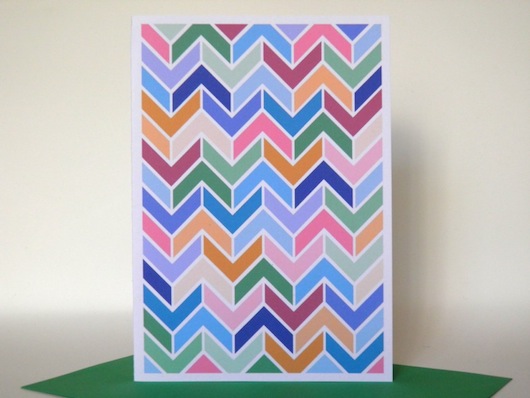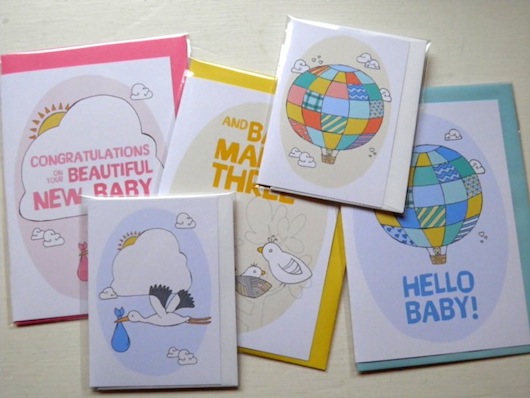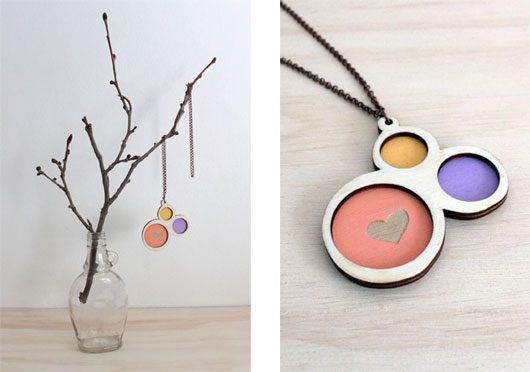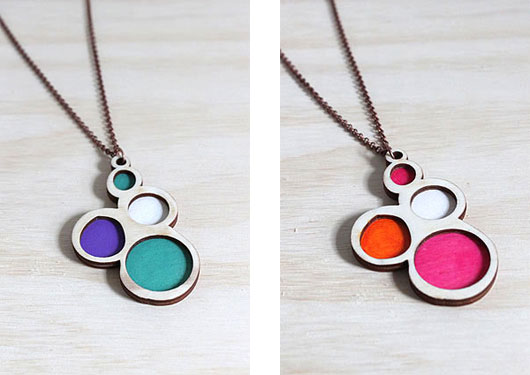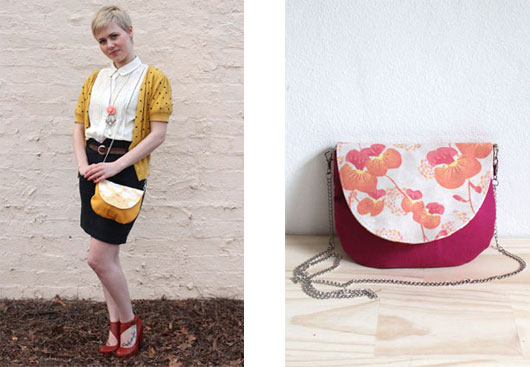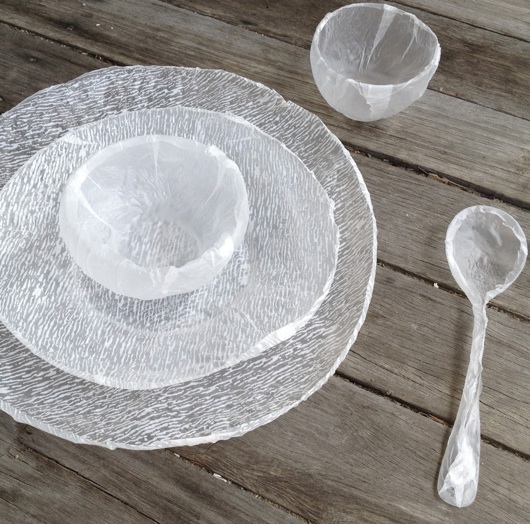A slow fashion success story
A social enterprise run by two creative women is bringing fabrics of Northern Territory indigenous communities to the world. Magpie Goose NT is the brainchild of Maggie McGowan and Laura Egan, two young entrepreneurs based in Katherine in the NT.
Photo by Maggie McGowan, Winnie Duncan from Urapunga, wearing Graham Badari's Nabarlek dja Ngarrbek (Rock Wallaby and Echidna) print.
A social enterprise run by two creative women is bringing fabrics of Northern Territory indigenous communities to the world. Magpie Goose NT is the brainchild of Maggie McGowan and Laura Egan, two young entrepreneurs based in Katherine in the NT.
Maggie and Laura work with Aboriginal art centres in four communities - Wadeye, Gunbalanya, Tiwi Islands and Maningrida - to produce screen printed fabric, designed by local artists, to be made into women’s, men’s and children’s clothing.
The name is a nod to the classic northern Australian bird, known for its distinct look and quirky behaviour.
“Magpie geese sit on top of mango trees and get drunk on the fermented mangoes,” says Maggie. “That idea is reflected in our brand; we’re bold, bright and strong.”
Maggie came up with the Magpie Goose concept during her travels to indigenous communities in the Territory, working with Aboriginal legal aid.
“I started discovering art centres, particularly the bright colours and patterns of the fabrics made there, and how they told incredible stories of that community,” says Maggie.
“I spent a lot of time going around and having a yarn. Art centres are often the hubs of communities, where artists sit down while they’re weaving or painting, and you can have a chat.”
Photo by Callum Flinn
Feeling disheartened by the underemployment in communities Maggie knew she wanted to contribute in a different way, other than through her legal work.
“There’s so much passion and interest around Aboriginal culture and products, I thought, if I can have my own social enterprise that provided employment opportunities, I could affect change.”
She and Laura pitched their case to Enterprise Learning Projects (ELP), an NT-based organisation supporting inclusive businesses in indigenous communities. ELP funded them to buy 200 metres of fabric to start the production process.
Maggie and Laura went to Bali and had a handful of garments produced in simple designs and started wearing the pieces themselves. At the end of 2016 they did a ‘soft’ launch in Darwin, before all their friends went down south for Christmas. They sold the majority of their pieces, and their customers wore the Magpie Goose garments over summer in other parts of the country, building further interest in the bold designs.
Each design tells a story of people, place and culture.
“There’s definitely a move for slow and ethical fashion and knowing the story behind the clothes you wear. Our clothing is a conversation starter.”
A lightning bolt moment came when Laura was chased through San Francisco airport by people asking her where her clothes were from.
“We then realised that there was a big demand for it,” says Maggie.
Photo by Sarah Mackie.Laura and Maggie (L to R)
The pair started a Kickstarter campaign and reached their target of $20,000 within 24 hours, ending up with over $100,000 of pre-orders.
An important part of the business model is ensuring opportunities for Aboriginal people to be involved, and Maggie says they hope to involve people from the communities that the fabric is produced, through writing stories of the artists and designs; modelling the garments; and liaising with the media.
Maggie says that eventually she’d like to have people in each community employed by Magpie Goose NT.
“Our next steps are to visit all the communities and finding out how Magpie Goose can best work alongside art centres, to enable their growth and provide opportunities as the business expands.”
Kate Shannon is a freelance writer based in Brisbane after many years living in Darwin. She spends a lot of her time in the garden with her two little girls, and loves writing and learning about creative people, families, flowers, and plants.
Image credits: Sarah Mackie, Maggie McGowan, Callum Flinn
Eco-Friendly Creative Practice: Penny Eager from Pocket Carnival
By Phoebe Miller
Our subject for this month's eco-friendly creative practice feature is so passionate about the issue that she has set up a website to share resources, tips and tools with others looking to make their creative practice or business more environmentally sustainable!
Penny Eager is the designer and maker behind Pocket Carnival, an art and design business based in Melbourne. Penny combines her love of sewing and drawing to produce eco-friendly purses, paper goods and baby toys and bibs.
She is also the driving force behind Oh My Green, a website that not showcases eco-friendly design and great DIY ideas, home and lifestyle tips, including a handy Eco-Resource Directory full of links and gems of info to help crafty and small business types green their business.
We thought it was only fitting that we take some time to share Penny's story and pick her brain based on her experience in establishing and running a small eco-friendly creative business!
How do you approach sustainability and environmental awareness in your creative practice?
A desire for social and environmental sustainability is part of my personal ideology. I think everyone in the world should have access to the same human rights.
When I started making crafty things which led to my business (over 5 years ago now!), I wasn't creating things in a particularly eco-friendly way. I definitely think that local production and handmade are a fantastic beginning, however as I increased the amount of things I was producing I began to feel uncomfortable with the increasing gap between my personal ethics and my business ethics - when you start producing a lot of items, the materials you're using really start to add up!
So, I started to look for more sustainable ways of creating things. In no way is Pocket Carnival a perfect example of an eco-friendly business, but I think all the little things we do can add up and are helpful. If I find a more eco-friendly alternative to a conventional material I will use it (like organic instead of regular cotton, or corn-based toy stuffing instead of regular stuffing).
The availability of different materials also influences my product range too - often it can be so much harder to find eco-friendly options for small production runs! I had been wanting to venture into the new baby industry for a little while, and luckily enough Melbourne-based awesome digitial printing business Frankie & Swiss offer an organic cotton knit that my dribble bibs are now made of.
Eco-friendly craft & business supplies is a rapidly growing area, I often find that things I couldn't find 6 months or 2 years ago are all of a sudden widely available, which is wonderful.
What key challenges have you come up against in trying to reduce the environmental impact of your work? How did you overcome them?
I guess the three main challenges I've found are cost, aesthetics and marketing.
Earlier this year I changed my greeting card packaging from biodegradable cellophane sleeves to polypropylene sleeves which I still feel pangs of guilt about! However I was getting a heap of feedback from shops stocking my cards that customers weren't buying the greeting cards in the cello sleeves as often, because the cello sleeves get a little bit wrinkly over time, they don't look shiny & new. I know we all love new shiny things! I weighed it up and after much angst I decided to go with plastic sleeves - I'd rather keep selling more cards than have a perfectly eco-friendly product that won't sell.
Marketing can also be difficult. I think because Pocket Carnival's products don't necessarily look 'eco', marketing them as organic and eco-friendly hasn't worked as well as it could have. I think naturally we all gain preconceived notions of what eco-friendly looks like, and if something strays too far from that it often won't register. So for me a challenge has been marketing, eco-friendly products that don't necessarily 'look' eco-friendly - trickier than it sounds!
Are there any particular resources you draw on to learn about issues around sustainability, in particular regarding design and production?
I studied politics and social studies at university, so this has absolutely influenced my little design business! My partner Chris has a Masters in Environmental Science and worked for a while in the environmental services industry. A lot of our friends also work in non-government organisations, trade unions and environmental organisations, which is definitely a massive influence. Can I call it peer pressure in the nicest way!? I think most of my friends would disown me if I started manufacturing in China.
The main reason I started Oh My Green is that it can be very difficult to find information and resources on environmentally and socially sustainable alternatives to traditional craft and business materials. It got to the point where I was getting a lot of emails asking me for information on my suppliers, materials and other random eco questions. Rather than constantly giving away my trade secrets and writing lengthy replies to questions, I decided to start the website!
 Pocket Carnival baby big and card
Pocket Carnival baby big and card
Is there anything you’d like to do or learn to further increase the environmental sustainability of your work?
Oh there are always so many things on the list! Everything from carbon offsetting to finding a zipper made of recycled plastic to purchasing a studio printer that uses vegetable based inks. I would love for Oh My Green to become a little more widely promoted too, especially so I can show people how easy it can be to make small changes to be just that little bit more eco-friendly.
 Pocket Carnival bib modelled by one cool kid!
Pocket Carnival bib modelled by one cool kid!
Who are the other creative women doing new or interesting things with a focus on environmental sustainability that you admire or are inspired by?
There are so many businesses and people, but definitely Lara and Teegs from Ink & Spindle are amazing - these ladies have not strayed from their core mission of making beautiful & timeless eco-friendly textiles.
Of course Kelley and the team behind Peppermint Magazine are an inspiration, especially for showing off the MANY many eco-friendly labels and inspiring people out there!
I also think Theresa from Rummage Style is pretty awesome - Rummage clothing is all made from vintage or repurposed fabrics here in Melbourne. And finally I'm just loving the motivation and inspiration behind The Smallest Tribe.
What advice would you give to women who hope to launch their own label with a sustainable focus?
Do it! Honestly I think part of the problem with climate change and environmental problems is that because the problem is so massive, we often feel powerless individually.
I think it would be completely amazing if our governments turned around and said 'Hey! pesticides are bad for our earth! Grow things organically!' or 'Dudes! Recycled papers can be used in nearly all the same contexts as non-recycled! So use that!', but they don't. I think it's definitely up to individuals, small businesses, big businesses and governments to work harder at being more environmentally sustainable. It can be really difficult, but I think we all have responsibilities!
However I would also love to say that if you try and be the most environmentally sustainable business ever, you will probably end up being extremely frustrated. You just have to figure out what you will and won't be willing to compromise on, and stick to it. You need to be able to align your personal and artistic / business ethics with each other. But, do it!
---
You can find out more about Penny over at Pocket Carnival, Oh My Green, or get in touch about her product range via penny/at/pocketcarnival.com.au.
Phoebe Miller is a Brisbane-bred, Sydney-fled, Melbourne-embedded gal who enjoys making, spruiking, collecting, exploring, telling her friends where to eat and posting photos of doors on instagram. After several years working in corporate marketing and communications, Phoebe followed the urge to explore her creative side. These days she divides her time between her sustainable fashion accessories label, Simply Phoebe, and freelance PR consulting.
Eco Friendly Creative Practice: Kim Stark from Emiti
 Kim Stark has followed a highly creative yet diverse career path, from child actor to assistant director, masseuse, and now the founder and designer behind Emiti, a range of gorgeous accessories and homewares.
Kim Stark has followed a highly creative yet diverse career path, from child actor to assistant director, masseuse, and now the founder and designer behind Emiti, a range of gorgeous accessories and homewares.
Originally hailing from Western Australia, Kim was a child actor before going on to work behind the scenes in film and tv. After deciding to pursue acting again, she started her own massage practice to support herself. During this time, she began sewing wheat bags for clients and friends. When they proved to be a hit, she decided to put her other creative skills to use by designing and printing her own fabric to give the eco-friendly products a more unique, personal touch.
Before long, Kim realised this creative outlet was what she kept coming back to and enjoyed the most and so she set about expanding her range into other products such as handbags, cushions and jewellery.
Sustainable and ethical design and production is central to the Emiti business model, from the use of organic fabrics and low carbon leather in the handbags, through to sourcing recycled plastic bottle inserts for cushions and FSC certified wood for jewellery products. Kim has kindly taken some time to share what she has learnt (and is still learning) along the way.
Emiti cushions
Necklaces from the new Emiti jewellery range
How do you approach sustainability and environmental awareness in your creative practice?
For me it’s about choices. There are a lot of decisions to be made in a creative business and I always try to choose materials and processes that are environmentally friendly. It’s not that much harder, it just requires a bit more patience and perseverance.
Some examples of what I’m currently doing is using organic cotton/hemp fabrics that I screenprint with water based inks, using recycled card for all my packaging and swing tags, posting everything out in secondhand boxes I source from local businesses, using FSC certified wood, low carbon leather, designing patterns so that there’s almost no wastage of fabric and then composting any fabric and cardboard scraps that later ends up on my vegie patch!
I think all of these choices are important because I don’t want to be just another business producing stuff that other people can buy and then later throw out. If people are going to buy pretty things that make them happy (and make me happy to make!) then I’d much rather they buy products from businesses that actually think about these environmental decisions.
The Florence bag from the South West Collection
What key challenges have you come up against in trying to reduce the environmental impact of your work and how did you overcome them?
The main challenge I’ve come across is the lack of supplies available in Australia for environmentally sustainable products and the increased prices of those supplies. Especially when it comes to fabric – there’s only a few sources of fabric, which limits what the end product will look like. I especially find it limited in terms of colours of fabrics available.
But on the flip side of that sometimes being restricted in what you can design can bring about an end result that works beautifully and wouldn’t have happened in the first place without the restriction. The main reason I chose to screenprint my own organic fabric was because there isn’t that wide choice available and that’s become a large part of what I do, so there’s always a positive!
As more and more consumers choose to buy environmentally friendly products, there’ll be a flow on effect in that more supplies will become available at a lower price. Are there any particular resources you draw on to learn about issues around sustainability, in particular regarding design and production?
I always find magazines, such as Peppermint, a great resource on what other groups are doing and interesting articles about processes.
I also find talking to different makers through markets and trade fairs a great way to swap knowledge and ideas. Also talking to the businesses that supply your materials as they are usually on top of what’s happening in their particular field. And let's not forget about our friend Google…
Necklaces from Emiti's new jewellery range
Is there anything you’d like to do or learn to further increase the environmental sustainability of your work?
I’d love to use more recycled materials in my products, especially in my new jewellery range, and hopefully I will find the time very soon to really do some solid research into what businesses are chucking out and how it can be reused. I love the idea of the creative process being informed by what’s available, you never know what the end result might be!
Some of my future goals are to become carbon neutral and to be in the position to donate a percentage of profits back to environmental causes.
Who are the other creative women doing new or interesting things with a focus on environmental sustainability that you admire or are inspired by?
I really admire what the girls at Harvest are doing. They host amazing craft workshops and have their own range of products made from organic and natural fabrics. The community they’ve built around sustainable craft is a great business model that I hope will soon spread far and wide.
Clutch bag from the South West Collection
What advice would you give to a young woman who hoped to launch their own label with a sustainable focus? Make sure you leave yourself enough time to do lots of research into every aspect of what you make and where you can source the best materials. Unfortunately there isn’t a magical website that lists all of best places so it can take a bit of detective work!
Make sure you know what your values are and what’s important to you when you start because it’s easy to get pushed into a direction that is maybe easier but isn’t necessarily better, so it’s good to know what your goals are.
But also be aware that when you’re starting out you can’t make your business 100% perfectly environmentally friendly. You have to be realistic about what is achievable at each stage of your business and know that as your business grows you can take those bigger environmental steps.
Phoebe Miller is a Brisbane-bred, Sydney-fled, Melbourne-embedded gal who enjoys making, spruiking, collecting, exploring, telling her friends where to eat and posting photos of doors on instagram. After several years working in corporate marketing and communications, Phoebe followed the urge to explore her creative side. These days she divides her time between her sustainable fashion accessories label, Simply Phoebe, and freelance PR consulting.
Eco-Friendly Practice: Northcity4
At our most recent CWC event, we heard from the group of talented and inspiring women who run Northcity4: an Artist Run Initiative encompassing a shared jewellery and object based design workspace in Brunswick, Melbourne. In addition to providing a workspace and innovative learning environment, Northcity4 is committed to promoting and supporting the integration of sustainability into all aspects of jewellery and object based practice.
During the talk, we heard from Ali Limb, one of NC4's founders and Board Members, about the group's sustainability measures. For those who couldn't make the event, and those who did and want to know more, I caught up with Ali to find out more about NC4's impressive approach to sustainability.
What led to your strong focus on sustainability as a group in the development of Northcity4?
From the start, Northcity4 was determined to create a healthy workplace with an environmentally aware approach. Because we were starting from scratch we saw this as a great opportunity to put steps in place to support this vision.
Through Sustainability Victoria we learnt that 80% of the footprint is locked in with the fit-out so this has informed our process from day one. The concept of the space is open plan and wherever possible the materials used are reclaimed such as our big white moveable wall which was kindly donated by ACCA.
Moveable wall donated by ACCA
Jewellery in particular has many negative impacts on the environment due to mining of metal and stones and chemicals used to clean and finish metal. We wanted to start by making ourselves aware of the issues and to gradually change the way we do things with the aim to reduce our environmental impact and potentially inspire and influence others.
What research and background work did you do to develop your sustainability policy and initiatives?
NC4 has begun a process of mapping the organisations life cycle. The first steps were to understand our potential impact and then begin to develop a policy, which addresses each area of concern. There are many steps needed to reach our ultimate goal but we see this as a journey.
To get started, NC4 signed up for 100% green gas, 25% green electricity (with the aim to increase this steadily), implemented a visible waste system using eco bins, a worm farm to convert our organic waste, plants for air cleaning and a microcline air filter for specific dust and fume extraction.The UBC donated a veggie box so we also grow our own rocket and herbs out the front.
From here we hope to eventually install solar panels, more insulation and begin to build a strong database of ethical suppliers with the plan to influence many of our piers and existing suppliers. We are continuing to research and collate information as we go.
Eco bin waste system at Northcity4
Were there any particularly useful resources you would recommend to other collectives or individuals looking to make their creative practice more environmentally sustainable?
We have been fortunate to receive support and advice from Sustainability Victoria with the initial Life Cycle mapping. NC4 has also signed up for Zero Carbon Moreland through Moreland Energy Foundation Ltd - another great resource.
We also recently signed up to Grow Me The Money, a program run by VECCI designed to help businesses reduce waste and use less resources.
As a jeweler I also often refer to ethical metal-smiths.
Can you tell me a little bit about the "plant pledge" and the reasoning behind it?
When we first started looking at ways to create a green workplace, an obvious option was to introduce plants to help with the air quality and also to create an uplifting environment. Katherine came across this great clip from the TED talks, which inspired us to introduce a plant pledge to our Opening Launch in March.
We had three examples of air cleaning plants and invited people to pledge between $5-$20 towards these plants. We then ordered the plants through CERES and potted them up in pots donated to NC4 or purchased through the tip shop. We are well on our way to greening our space with plants.
Plants purchased with the funds from NC4 plant pledge
Microclene air filter for more specific extraction
I love the sound of your community lunches - how do these contribute to your sustainability focus?
NC4 monthly lunches are an opportunity for the NC4 tenants and board members to invite guests to the studio to share a delicious simple lunch and conversation. The food is all organic and usually purchased at Ceres Saturday market. These lunches often lead to new connections between friends of NC4 and the wider community.
What has been the biggest challenge in addressing sustainability as a collective?
Trying to achieve our goals on a small budget and with limited time is the biggest challenge. We are also working with a large space and an old building; this has presents challenges in regard to insulation and maintaining heat during winter. Our first investment in the building was to insulate the roof with air-cell insulation and install light boxes in the ceiling to give good natural light.
What other projects and opportunities do you have in place to promote sustainability?
As a way of making a more public statement and also creating opportunities for artists working in recycled/reclaimed materials with an environmental message we have a project which involves inviting artists to create and installation on our front window and gate to engage the passing community.
Recent artists involved were Pennie Jagiello and Claire McArdle.
Pennie with her "Speech Bubble" installation in the NC4 front window
Pennie's Speech Bubble piece (above), made from reclaimed trawling net, plastic bags & plastic milk bottles, addressed the issue of ghost nets and raised our awareness about the marine life that is unintentionally caught in these stray nets.
Big Blue Jellyfish (below) was made from plastic bags often mistaken at sea for jellyfish. Pennie also made us aware of the Great Pacific Garbage Patch a giant garbage dump of 44 million kilos of plastic waste floating in the Pacific Ocean.
"Big Blue Jellyfish" by Pennie Jagiello
For her installation, Claire McArdle used recycled "green" bags. Find out more in Claire's NC4 guest blog post.
Claire installing her piece at NC4
Claire's gate adornment
As an individual jeweller who works with precious metals, how are you approaching the desire to make your work more environmentally sustainable?
My jewellery practice has been affected by the research and actions we are taking through NC4. At first the information brought my jewellery to a bit of a standstill, but having begun to work through the issues that have been raised, I am beginning to look at my jewellery differently and finding ways I can reuse materials from previous collections.
I have also set myself the goal to limit myself to work with materials (stones & beads) I have collected over the past 20 years whilst I work toward sourcing my materials via more ethically methods.
Recently Anna Davern (another NC4 Board Member) and I were asked to be involved in an exhibition called Once More With Love. This project involves working with a bag of preloved jewellery and making a piece of contemporary jewellery. The results are great but it was a seriously challenging brief.
Phoebe Miller is a Brisbane-bred, Sydney-fled, Melbourne-embedded gal who enjoys making, spruiking, collecting, exploring, telling her friends where to eat and posting photos of doors on instagram. After several years working in corporate marketing and communications, Phoebe followed the urge to explore her creative side. These days she divides her time between her sustainable fashion accessories label, Simply Phoebe, and freelance PR consulting.
Eco-Friendly Creative Practice: Jules Clancy
By Phoebe Miller Food, glorious food. For what is really a simple, basic human need, it's a complex topic these days, not least of all when it comes to addressing sustainability. What we eat and how source, prepare and eat it can have a huge environmental impacts.
I don't know about you, but the plethora of information and choices surrounding these issues can be overwhelming, especially at 6pm when all really want to do is work out what's for dinner! However, sometimes taking small, simple measures are all you need to get started on the right track. Sydney-based food lover and blogger, Jules Clancy, has set out to show us just how easy it can be to cook quick meals that are healthy, sustainable and affordable!
 A big pot of beans, via Stonesoup
A big pot of beans, via Stonesoup
What do you do? I blog about delicious healthy meals in minutes over at www.thestonesoup.com. I also teach people from all over the world the art of simple, healthy cooking on my online cooking school.
How do you approach sustainability and environmental awareness in your creative practice? For me it’s all about sourcing sustainable ingredients from producers who care about food. I’m also experimenting with my own small veggie garden.
 Sprout & Pumpkin Salad, via Stonesoup
Sprout & Pumpkin Salad, via Stonesoup
Can you tell me about one or two of your favourite projects that showcase this approach best? I ran a class last year called ‘Mastering the Art of Cooking on a Budget’. Basically I documented myself feeding myself for a week on $5 a day using minimal processed food. The class was ‘pay what you can afford’ and I got an awesome response from my students who had discovered that healthy food doesn’t need to take a lot of time or skill, nor does it necessarily have to be expensive.
What challenges have you come up against in trying to make your work more sustainable and how did you overcome them? The biggest challenge for me is figuring out which options truly are the best from a sustainability perspective. If something is organic but has been shipped from further away is it better or worse than locally produced conventional produce?
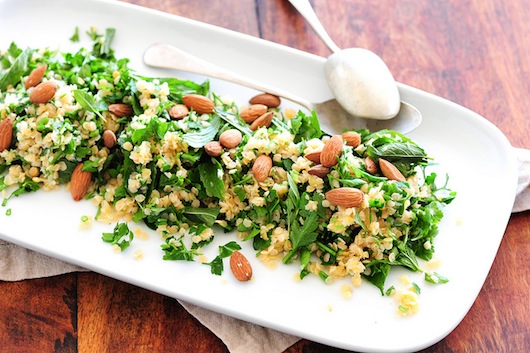 Lentil Tabbouleh, via Stonesoup
Lentil Tabbouleh, via Stonesoup
Is there anything you’d like to do or learn to further increase the environmental sustainability of your work? I’d love to learn more about sustainable seafood... which species are best for the environment and for our bodies.
Who are the other creative women doing new or interesting things with a focus on environmental sustainability that you admire or are inspired by? Tough one. I love what Alice Waters in the US and Stephanie Alexander in Australia have done with introducing ‘edible playground’ and ‘kitchen garden’ programs into schools to educate children about where food comes from and how to prepare delicious healthy food.
Phoebe Miller is a Brisbane-bred, Sydney-fled, Melbourne-embedded gal who enjoys making, spruiking, collecting, and exploring. After several years working in corporate marketing and communications, Phoebe followed the urge to explore her creative side. These days she divides her time between her sustainable fashion accessories label, Simply Phoebe, and freelance PR consulting.
Eco-Friendly Creative Practice: Supercyclers
By Phoebe Miller I'm interrupting this month's regular Eco-Friendly Creative Practice interview programming to highlight a very worthy event in the world of local sustainable design: the Supercyclers exhibition currently running in Sydney.
I'm sure many of you are no strangers to their work. Supercyclers are an ever growing international collective of designers who take waste materials and transform them into very beautiful, and often highly useful new products.
After successfully leveraging a campaign on the local crowd funding site Pozible, Sarah King - one of the original Supercyclers - took an exhibition of new supercycling work to The Other Hemisphere at Milan Design Week. The "Supercycle Our Souls" exhibition is now back on home shores and available for your viewing pleasure in Sydney.
In honour of the event, and to make up for not being in Sydney to see it myself, I thought it would be fitting to highlight the work the local creative ladies that are part of this exciting exhibition.
 Plastic Fantastic Transparent Collection
Images via Supercyclers
Plastic Fantastic Transparent Collection
Images via Supercyclers
As part of her own supercycling work Sarah K works with another sustainable design dynamo, Liane Rossler, as Plastic Fantastic. Their stunningly gorgeous ethereal looking creations are made from discarded single use plastic bags.
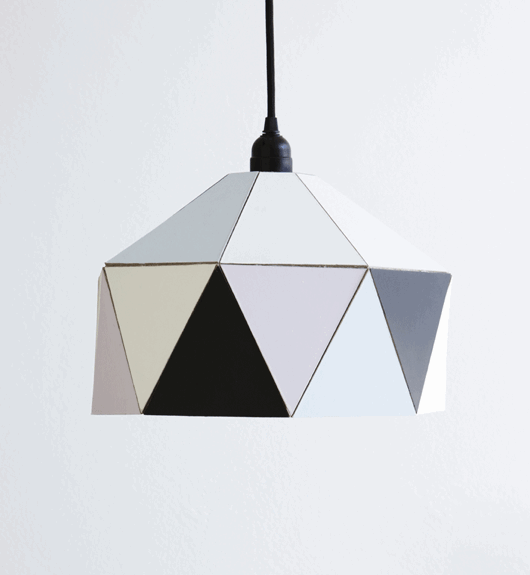 Quilt light by Tamara Maynes (photo by Andy Lewis)
Image via Supercyclers
Quilt light by Tamara Maynes (photo by Andy Lewis)
Image via Supercyclers
 Broken ceramic plates repaired with coloured glue by Tamara Maynes
(styled by Vanessa Colyer Tay, photo by Sam McAdam)
Image via Supercyclers
Broken ceramic plates repaired with coloured glue by Tamara Maynes
(styled by Vanessa Colyer Tay, photo by Sam McAdam)
Image via Supercyclers
Tamara Maynes is something of a craft queen, with a tendency to re-use and see the beauty in the discarded. Her Quilt Lamp (pictured further above and right below), which is featured in the exhibition, is available as a downloadable template that can be made from any flat, stiff material.
 Tamara Maynes Quilt Light made from recycled cardboard
Image via Supercyclers
Tamara Maynes Quilt Light made from recycled cardboard
Image via Supercyclers
I should note that supercyclers are an equal opportunity collective! ;) While we're all about awesomely talented ladies at the CWC, you can also check out what the supercyclin' boys are up to on the supercyclers website.
SOS (Supercycle Our Souls) runs until July 15 at Moore Park Supacentre. Venue details here.
Phoebe Miller is a Brisbane-bred, Sydney-fled, Melbourne-embedded gal who enjoys making, spruiking, collecting, exploring, telling her friends where to eat and posting photos of doors on instagram. After several years working in corporate marketing and communications, Phoebe followed the urge to explore her creative side. These days she divides her time between her sustainable fashion accessories label, Simply Phoebe, and freelance PR consulting.
Eco-Friendly Practice: Georgia McCorkill
By Phoebe Miller The pitfalls of fast fashion have rightly come under the spotlight in recent years, namely the effect on designers who struggle to compete with cheap product mass produced offshore and the impact on the environment. This month, we caught up with a local designer who's striving to make a positive impact with her work.
Georgia McCorkill's The Red Carpet Project is a design driven collaboration between designers, celebrities, stylists and publicists that uses the captivating properties of the fashion worn on the red carpet to raise awareness of environmental problems faced by the fashion industry. The project forms part of a PhD in Architecture and Design that Georgia is undertaking at RMIT University.
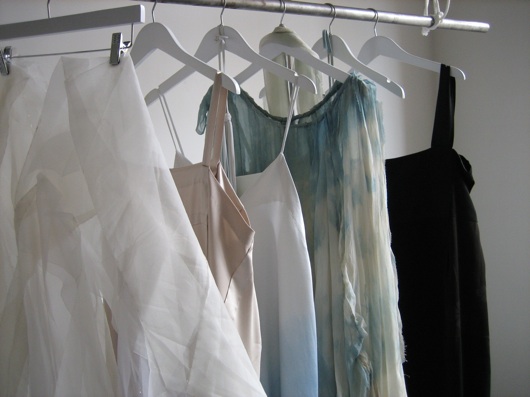 Garments featured in The Front Row Project at LMFF 2012
Garments featured in The Front Row Project at LMFF 2012
What do you do/ design/ make? I design special occasion dresses that are informed by principles of design for sustainability. I find situations where the dresses will come to public notice, be it a red carpet event, a wedding, the front row of a fashion parade or on the catwalk itself, and then I engage participants involved with these events such as actresses, publicists and the like in order to make a project happen.
The interesting thing about what I do is that my work attracts praise for making sustainable fashion appeal to a popular audience through its pleasing aesthetic, yet it’s not at this point a commercial endeavor, it’s a creative activist practice.
 Oscars dress design shortlisted for Suzy Amis Cameron’s Red Carpet Green Dress competition
Oscars dress design shortlisted for Suzy Amis Cameron’s Red Carpet Green Dress competition
How do you approach sustainability and environmental awareness in your creative practice? The starting point for my designs is the idea that a special occasion dress is often only worn once, therefore its requirements for durability are minimal.
Current approaches to design for sustainability tend to focus on employing a range of design strategies as appropriate to the situation, such as recycling, re-use, design for disassembly, etc. I pretty much work within this framework, and try to constantly evolve new iterations of these strategies that I think are more innovative and better than the last. For instance, earlier work has focused on the use of natural plant dyes as well as upcycling fabric remnants. I continue to do these things, but my latest work has been more focused around designing dresses so that they can be disassembled and re fitted, thus facilitating sharing between wearers.
 Fair@Square Fair Fashion Parade. Photography by Chealse Vo.
Fair@Square Fair Fashion Parade. Photography by Chealse Vo.
Can you tell me about one or two of your favourite projects that showcase this approach best? My most recent project was called “The Front Row”. I was interested in showcasing a model of fashion whereby the dresses can be shared, with the designer acting as a moderator and custodian.
The similarities between the celebrities who walk the red carpet and the fashion people who occupy the front row of the fashion parade inspired me to use the L’Oreal Melbourne Fashion Festival as a setting for the project. As part of the LMFF Cultural Program I created a range of dresses that were worn by people attending the fashion parades throughout the festival. The pieces were returned to me after wearing, and I made alterations such as dyeing or re-styling so that another person could wear the same piece again to a new event. I ran the project from a pop up studio space that was open to the public and it was a manic but really fun three weeks of activity.
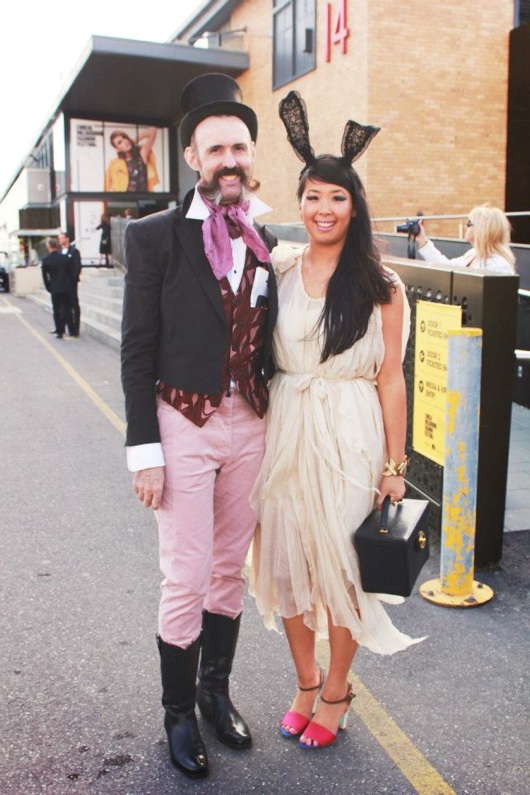 Lisa Teh from Couturing (right) a creations for The Front Row, with Richard Nylon
Image by Wanda Chin for Couturing
Lisa Teh from Couturing (right) a creations for The Front Row, with Richard Nylon
Image by Wanda Chin for Couturing
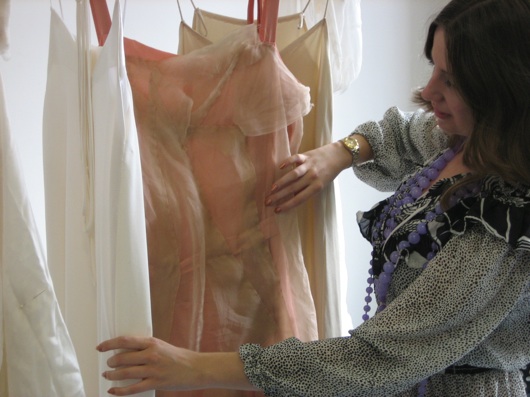 Lady Melbourne perusing Georgia's The Front Row collection
Lady Melbourne perusing Georgia's The Front Row collection
How and/ or where do you source your materials? I source remnants from bridal couture designers; the spaces that surround a pattern piece when it is cut out. These fabrics are of exceptional quality and ideal for processes such as dyeing. The odd shapes have come to determine many aspects of how I make the dresses, and I have developed a way of working with the remnant shapes in all their oddity without having to tame them too much.
Other fabrics might come from remnants from second hand kimonos, or fabric store remnants at the ends of rolls.
One issue when you talk about materials is that sustainability tends to focus on materials usage and issues such as recycling or organics. It’s a challenge to think beyond these things and imagine all of the other ways that fashion could be that embrace fashion not just as material production but as a symbolic cultural phenomenon.
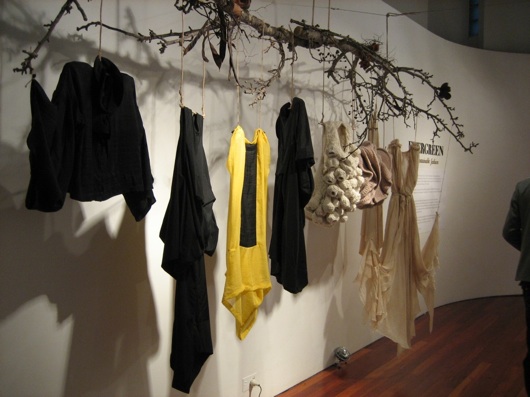 Evergreen: fresh sustainable fashion exhibition at Object
From left to right: Holly McQuillan, Julia Knupfer and Georgia McCorkill
Evergreen: fresh sustainable fashion exhibition at Object
From left to right: Holly McQuillan, Julia Knupfer and Georgia McCorkill
What challenges have you come up against in trying to make your practice sustainable and how did you overcome them? It wasn’t as though I had an unsustainable practice and then I tried to make it sustainable. It started with an idea of how I wanted this practice to be and then I worked towards that. The real world nature of the projects means that what you would ideally like to do is not always possible, because everyone involved has to be satisfied that my designs will fulfil the purpose they have imagined for it.
I’ve come to enjoy though exploring the possibilities for this more conciliatory approach to design, because ordinarily as a fashion designer you are encouraged to see yourself in a much more authoritarian role.
Is there anything you’d like to do or learn to further increase the environmental sustainability of your creative practice? My future aspirations are to continue to use design in a spirit of activism to encourage innovation in the ways we make, consume and relate to clothes and fashion.
 Cheryl Lin donning a piece from The Front Row collection for the Business Chic Little Black Dress Project
Cheryl Lin donning a piece from The Front Row collection for the Business Chic Little Black Dress Project
Who inspires you? I’m really inspired by anyone who is challenging fashion not just from and aesthetic perspective but from a systematic and cultural point of view.
All images in this post courtesy of Georgia McCorkill and The Red Carpet Project, unless otherwise noted.





